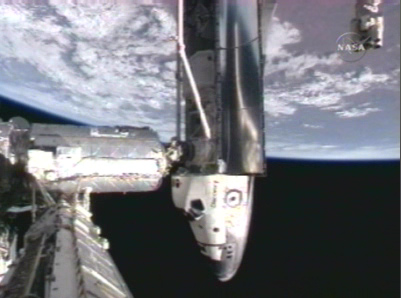Mission Discovery: Shuttle Astronauts Dock at ISS

This story was updated at 9:55 p.m. EST.
HOUSTON-Seven astronauts arrived at the International Space Station (ISS) late Monday as NASA's shuttle Discovery docked with the orbital laboratory for a crew swap and an intense week of spacecraft construction.
Contact occurred at 5:12 p.m. EST (2212 GMT) as shuttle commander Mark Polansky eased Discovery into a berth at the end of the station's U.S. Destiny laboratory.
"Capture confirmed," said Discovery pilot Bill Oefelein.
"Welcome aboard," said station commander Michael Lopez-Alegria.
The successful docking, which happend just after orbital sunrise and while both spacecraft hovered some 220 miles above southeast Asia, ended a two-day chase that began with the shuttle's successful night launch Saturday.
Shortly prior to docking, Polansky guided Discovery through a 360-degree backflip so ISS crewmembers could photograph heat shields on the shuttle's underside to look for any damage that might have been incurred during launch [image]. In-orbit inspections have been standard since the 2003 Columbia tragedy that killed seven astronauts.
Preliminary data from shuttle and ground cameras and radar in place during Discovery's launch have revealed nothing of concern, and the spacecraft looks to be in good condition, NASA officials said yesterday.
Breaking space news, the latest updates on rocket launches, skywatching events and more!
"The long range cameras showed typical performance. You could see a few very small pieces of foam or ice come off-none impacted the orbiter," NASA deputy space shuttle manager John Shannon said of Discovery's launch. "The pad cameras showed very good performance, it was the best external tank condition we have seen to date since return to flight."
Flying onboard Discovery with Polansky and Oefelein are mission specialists Robert Curbeam, Nicholas Patrick, Joan Higginbotham, Sunita Williams and Christer Fuglesang, a representative of the European Space Agency (ESA) and Sweden's first astronaut.
Hatch opening between the orbiter and the ISS occurred at 6:54 p.m. EST (2354 GMT) and was signaled by a traditional ringing of the station bell. "Space shuttle Discovery, arriving," Expedition 14 commander Michael Lopez-Alegria said in welcome. The crews of the two spacecrafts shook hands, hugged and took a quick group photo before returning to their busy schedules.
Beginning tomorrow, the STS-116 crew will stage three spacewalks to install a new $11 million Port 5 (P5) spacer segment to the ISS and rewire the orbital laboratory's electrical grid so it can switch to a permanent power configuration [image].
Crew swap
After docking, Patrick used Discovery's 50-foot (15-meter) long robotic arm to latch onto the P5 truss segment in the shuttle's payload cargo bay. The two-ton P5 segment remained poised at the end of the shuttle arm while the station's robotic arm performed an unscheduled inspection of Discovery's left wing leading edge, after sensors detected a very low-velocity impact early this morning while the crew was asleep.
P5 will be transferred from the shuttle arm to the station arm later tonight, in preparation for its installation onto the orbital laboratory by Curbeam and Fuglesang tomorrow during the first of three spacewalks planned for the mission. To prepare for their extravehicular activity (EVA), the two spacewalkers will spend the night in the station's Quest airlock, which will be shut early tomorrow morning at 12:37 a.m. EST (0537 GMT).
Nicknamed the EVA "campout," the move allows spacewalkers to purge nitrogen from their bodies while they sleep at a slightly lower atmospheric pressure - 10.2 psi - rather than the standard 14.7 psi aboard Discovery or the ISS.
Williams will officially relieve German astronaut Thomas Reiter tonight as Expedition 14's flight engineer by transferring her Soyuz spacecraft seat liner to the ISS, which will become her new home for the next six months. She will become the third woman to serve as part of an Expedition crew, preceded only by Susan Helms of Expedition 2 and Peggy Whitson of Expedition 5.
Her crewmates will be Lopez Alegria and Expedition 14 flight engineer Mikhail Tyurin. Reiter, who has been on board the ISS since July, will return to Earth with Discovery's crew on Dec. 21.
- Images: Discovery's STS-116 Launch Day Gallery
- STS-116 Video: Power is Everything
- STS-116 Video: Building Blocks
- Mission Discovery: The ISS Rewiring Job of NASA's STS-116
- Complete Space Shuttle Mission Coverage
- The Great Space Quiz: Space Shuttle Countdown
- All About the Space Shuttle
Ker Than is a science writer and children's book author who joined Space.com as a Staff Writer from 2005 to 2007. Ker covered astronomy and human spaceflight while at Space.com, including space shuttle launches, and has authored three science books for kids about earthquakes, stars and black holes. Ker's work has also appeared in National Geographic, Nature News, New Scientist and Sky & Telescope, among others. He earned a bachelor's degree in biology from UC Irvine and a master's degree in science journalism from New York University. Ker is currently the Director of Science Communications at Stanford University.
